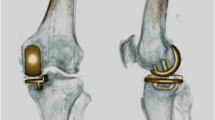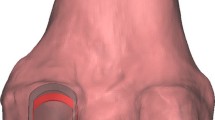Abstract
Purpose
Unicompartmental knee arthroplasty (UKA) has recently regained popularity for the treatment of osteoarthritis of the knee. Numerous authors have cited alignment as an important prognostic factor in the survival of UKA. Limb alignment affects not only the longevity of UKA by influencing wear of polyethylene, but also affects the unreplaced contralateral compartment. Malpositioning of the components may result in unequal wear patterns, thus further leading to early failure and additionally influencing clinical outcome as well. However, there is a lack of techniques to assure a high accuracy of the implant positioning.
Methods
In this study, we investigated tibia component alignment of 28 medial UKAs implanted with patient-specific cutting blocks. Three patients were excluded due to bad imaging. Measurements of tibial component alignment from postoperatively computed tomography (CT) scans were compared to respective CT-based preoperative plannings to assess the accuracy of implant positioning.
Results
Our results show excellent high accuracy of tibial implant position in tibial varus/valgus (Δ 0.3° ± 1.7°), posterior slope (Δ 1.1° ± 2.6°) and external rotation (Δ 1.5° ± 3.3°).
Conclusion
We conclude that patient-specific cutting blocks improve the accuracy of tibia component positioning in unicompartmental knee arthroplasty.
Level of evidence
Case series with no comparison group, Level IV.


Similar content being viewed by others
References
Ackroyd CE (2003) Medial compartment arthroplasty of the knee. J Bone Joint Surg Br 85(7):937–942
Campbell DG, Johnson LJ, West SC (2006) Multiparameter quantitative computer-assisted tomography assessment of unicompartmental knee arthroplasties. ANZ J Surg 76(9):782–787
Cobb J, Henckel J, Gomes P, Harris S, Jakopec M, Rodriguez F, Barrett A, Davies B (2006) Hands-on robotic unicompartmental knee replacement: a prospective, randomised controlled study of the acrobot system. J Bone Joint Surg Br 88(2):188–197
Diezi C, Wirth S, Meyer DC, Koch PP (2010) Effect of femoral to tibial varus mismatch on the contact area of unicondylar knee prostheses. Knee 17(5):350–355
Dunbar NJ, Roche MW, Park BH, Branch SH, Conditt MA, Banks SA (2012) Accuracy of dynamic tactile-guided unicompartmental knee arthroplasty. J Arthroplast 27(5):803–808
Engh GA, Dwyer KA, Hanes CK (1992) Polyethylene wear of metal-backed tibial components in total and unicompartmental knee prostheses. J Bone Joint Surg Br 74(1):9–17
Hernigou P, Deschamps G (2004) Posterior slope of the tibial implant and the outcome of unicompartmental knee arthroplasty. J Bone Joint Surg Am 86-A(3):506–511
Hernigou P, Deschamps G (2004) Alignment influences wear in the knee after medial unicompartmental arthroplasty. Clin Orthop Relat Res 423:161–165
Hernigou P, Poignard A, Filippini P, Zilber S (2008) Retrieved unicompartmental implants with full pe tibial components: the effects of knee alignment and polyethylene thickness on creep and wear. Open Orthop J 2:51–56
Koch PP, Müller D, Pisan M, Fucentese SF (2013) Radiographic accuracy in TKA with a CT-based patient-specific cutting block technique. Knee Surg Sports Traumatol Arthrosc 21(10):2200–2205
Koeck FX, Beckmann J, Luring C, Rath B, Grifka J, Basad E (2011) Evaluation of implant position and knee alignment after patient-specific unicompartmental knee arthroplasty. Knee 18(5):294–299
Lustig S, Scholes CJ, Oussedik SI, Kinzel V, Coolican MR, Parker DA (2013) Unsatisfactory accuracy as determined by computer navigation of VISIONNAIRE patient-specific instrumentation for total knee arthroplasty. J Arthroplast 28(3):469–473
Mariani EM, Bourne MH, Jackson RT, Jackson ST, Jones P (2007) Early failure of unicompartmental knee arthroplasty. J Arthroplast 22(6 Suppl 2):81–84
Martinez-Carranza N, Weidenhielm L, Crafoord J, Hedstrom M (2012) Deviation between navigated and final 3-dimensional implant position in mini-invasive unicompartmental knee arthroplasty: a pilot study in 13 patients. Acta Orthop 83(6):625–628
Noticewala MS, Geller JA, Lee JH, Macaulay W (2012) Unicompartmental knee arthroplasty relieves pain and improves function more than total knee arthroplasty. J Arthroplast 27(8 Suppl):99–105
O’Rourke MR, Gardner JJ, Callaghan JJ, Liu SS, Goetz DD, Vittetoe DA, Sullivan PM, Johnston RC (2005) The John Insall Award: unicompartmental knee replacement. A minimum twenty-one-year follow-up, end-result study. Clin Orthop Relat Res 440:27–37
Servien E, Fary C, Lustig S, Demey G, Saffarini M, Chomel S, Neyret P (2011) Tibial component rotation assessment using CT scan in medial and lateral unicompartmental knee arthroplasty. Orthop Traumatol Surg Res 97(3):272–275
SooHoo NF, Sharifi H, Kominski G, Lieberman JR (2006) Cost-effectiveness analysis of unicompartmental knee arthroplasty as an alternative to total knee arthroplasty for unicompartmental osteoarthritis. J Bone Joint Surg Am 88(9):1975–1982
Stronach BM, Pelt CE, Erickson J, Peters CL (2013) Patient-specific total knee arthroplasty required frequent surgeon-directed changes. Clin Orthop Relat Res 471(1):169–174
Swienckowski JJ, Pennington DW (2004) Unicompartmental knee arthroplasty in patients sixty years of age or younger. J Bone Joint Surg Am 86-A Suppl 1(Pt 2):131–142
Valenzuela GA, Jacobson NA, Geist DJ, Valenzuela RG, Teitge RA (2013) Implant and limb alignment outcomes for conventional and navigated unicompartmental knee arthroplasty. J Arthroplast 28(3):463–468
Weber P, Crispin A, Schmidutz F, Utzschneider S, Pietschmann MF, Jansson V, Müller PE (2013) Improved accuracy in computer-assisted unicondylar knee arthroplasty: a meta-analysis. Knee Surg Sports Traumatol Arthrosc 21(11):2453–2461
Conflict of interest
The authors declare a financial and inventor relationship with Medacta® Switzerland.
Author information
Authors and Affiliations
Corresponding author
Rights and permissions
About this article
Cite this article
Dao Trong, M.L., Diezi, C., Goerres, G. et al. Improved positioning of the tibial component in unicompartmental knee arthroplasty with patient-specific cutting blocks. Knee Surg Sports Traumatol Arthrosc 23, 1993–1998 (2015). https://doi.org/10.1007/s00167-014-2839-2
Received:
Accepted:
Published:
Issue Date:
DOI: https://doi.org/10.1007/s00167-014-2839-2




